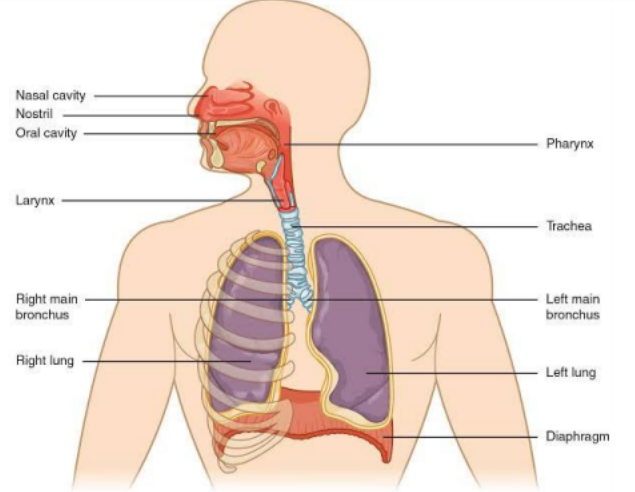
Answer
412.5k+ views
Hint: This system entails the team of organs and tissues that helps in respiratory and gaseous exchange. The manner of gaseous change happens in the lungs. They are the main organs that are positioned in the thorax.
Complete answer:
In the human respiratory system, the cells utilize oxygen for metabolism and produce strength alongside with carbon dioxide which is harmful. The human respiratory machine involves distinctive components for the change of gases:
External nostrils: They are existing in a pair that opens out above the top lips. They assist in the consumption of air.
Nasal chamber: External nostrils lead to a nasal chamber which is lined with hair and mucus to filter the air and remove dust.
Nasopharynx: It is a passage that is present at the back of the nasal chamber which is frequent for meals and air.
Larynx: It is a cartilaginous box which is additionally referred to as a sound box. It plays a key role in sound production.
Trachea: The trachea is a tube that gets located up to the mid-thoracic cavity. It types bronchi through dividing at the stage of the fifth thoracic vertebra.
Bronchi: The trachea categorised the fifth thoracic vertebra into left and right bronchi.
Bronchioles: Each bronchus further divided to produce the secondary and tertiary bronchi and bronchioles.
Alveoli: Each terminal bronchiole varieties countless very thin, irregular walled and vascularized bag-like buildings known as alveoli.
Lungs: The lungs contain the branching network of bronchi, bronchioles, and alveoli. They are currently in a pair which are blanketed by means of a double-layered pleura. There is a pleural fluid-filled between the lungs and pleura.
Diaphragm: It is the strong wall of muscle that leads to the suction to draw in air and expands the lungs.

Note: The pleural fluid plays a key role in the reduction of friction on the lung-surface. The diaphragm and the external and internal intercostal muscles that are located in between the ribs help in breathing.
Oxygen binds with haemoglobin to give rise to the oxyhemoglobin and each hemoglobin molecule can carry a maximum of four molecules of oxygen.
Complete answer:
In the human respiratory system, the cells utilize oxygen for metabolism and produce strength alongside with carbon dioxide which is harmful. The human respiratory machine involves distinctive components for the change of gases:
External nostrils: They are existing in a pair that opens out above the top lips. They assist in the consumption of air.
Nasal chamber: External nostrils lead to a nasal chamber which is lined with hair and mucus to filter the air and remove dust.
Nasopharynx: It is a passage that is present at the back of the nasal chamber which is frequent for meals and air.
Larynx: It is a cartilaginous box which is additionally referred to as a sound box. It plays a key role in sound production.
Trachea: The trachea is a tube that gets located up to the mid-thoracic cavity. It types bronchi through dividing at the stage of the fifth thoracic vertebra.
Bronchi: The trachea categorised the fifth thoracic vertebra into left and right bronchi.
Bronchioles: Each bronchus further divided to produce the secondary and tertiary bronchi and bronchioles.
Alveoli: Each terminal bronchiole varieties countless very thin, irregular walled and vascularized bag-like buildings known as alveoli.
Lungs: The lungs contain the branching network of bronchi, bronchioles, and alveoli. They are currently in a pair which are blanketed by means of a double-layered pleura. There is a pleural fluid-filled between the lungs and pleura.
Diaphragm: It is the strong wall of muscle that leads to the suction to draw in air and expands the lungs.

Note: The pleural fluid plays a key role in the reduction of friction on the lung-surface. The diaphragm and the external and internal intercostal muscles that are located in between the ribs help in breathing.
Oxygen binds with haemoglobin to give rise to the oxyhemoglobin and each hemoglobin molecule can carry a maximum of four molecules of oxygen.
Recently Updated Pages
Who among the following was the religious guru of class 7 social science CBSE

what is the correct chronological order of the following class 10 social science CBSE

Which of the following was not the actual cause for class 10 social science CBSE

Which of the following statements is not correct A class 10 social science CBSE

Which of the following leaders was not present in the class 10 social science CBSE

Garampani Sanctuary is located at A Diphu Assam B Gangtok class 10 social science CBSE

Trending doubts
A rainbow has circular shape because A The earth is class 11 physics CBSE

Which are the Top 10 Largest Countries of the World?

Fill the blanks with the suitable prepositions 1 The class 9 english CBSE

Which of the following was the capital of the Surasena class 6 social science CBSE

How do you graph the function fx 4x class 9 maths CBSE

The Equation xxx + 2 is Satisfied when x is Equal to Class 10 Maths

Give 10 examples for herbs , shrubs , climbers , creepers

Difference between Prokaryotic cell and Eukaryotic class 11 biology CBSE

Who was the first Director General of the Archaeological class 10 social science CBSE




